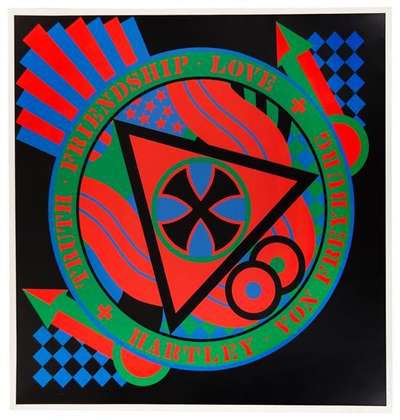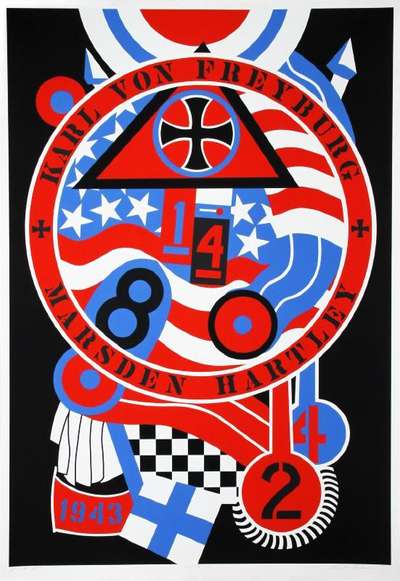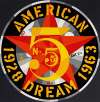The
Hartley Elegies
Find out more about The Hartley Elegies series, browse prints & editions for sale & view the works wanted by active buyers right now.
Robert Indiana The Hartley Elegies For sale
The Hartley Elegies Value (5 Years)
Robert Indiana's The Hartley Elegies series has historically shown more modest results compared with the artist’s wider oeuvre, with auction prices ranging from £691 to £4397. Average annual growth has remained modest at -1.28%, with certain works seeing declines in value. Over 8 total auction appearances, average selling prices have held steady around £1982. This series appeals to collectors seeking accessible entry points into Robert Indiana’s print market.
The Hartley Elegies Market value
Auction Results
| Artwork | Auction Date | Auction House | Return to Seller | Hammer Price | Buyer Paid |
|---|---|---|---|---|---|
 KVF VIII Robert Indiana Signed Print | 7 Dec 2022 | Wright | £553 | £650 | £850 |
 KVF II Robert Indiana Signed Print | 1 May 2018 | Ro Gallery | £2,125 | £2,500 | £3,000 |
Sell Your Art
with Us
with Us
Join Our Network of Collectors. Buy, Sell and Track Demand
Meaning & Analysis
Robert Indiana paid tribute to the so-called ‘the painter of Maine’ Marsden Hartley through a series of prints inspired by the latter’s ‘German Officer’ paintings.
Marsden Hartley, an American modernist painter, derived inspiration for his work from the work of European cubists. While in the United States, he occupied a position at the vanguard of abstract painting, where he was faced with vehement criticism. After returning to his home country, he would blend more determinable subject matter, such as landscapes, seascapes, and portraits, with the abstract methods he had encountered while travelling in Europe.
Hartley’s abstract portraits are noted as being significant reflections of the shifting understanding of subjectivity and personhood in the early twentieth century. This is an idea also reflected in Indiana’s representation of people through assemblage of symbolic references, such as in An Honest Man Has Been President: A Portrait Of Jimmy Carter.
Indiana moved to Vinalhaven in 1978, and would remain in residence there until his death in 2018. During this period, much of his work consisted of revisiting existing images in sculpture. After learning that Hartley resided in Vinalhaven for a short period of time in the late 1930s, Indiana began to take great interest in the artist’s work. His attention focussed on the German Officer series of paintings dedicated to Hartley’s purported lover, Karl von Freyburg, a German soldier who died in battle in October 1914. Not only did Indiana appear to take interest in the themes of Hartley’s work, but also saw parallels between Hartley’s life and his own: “It seemed that he was simply plagued with misfortune. And in a sense, I feel that I have also been plagued by misfortune. Just my exile in Maine has been a misfortune.”
It is thought that Hartley, like Indiana, endeavoured to keep his homosexuality concealed from the public eye. Nevertheless, the German Officer series is loaded with allusions to the artist’s affection for the fallen soldier, to the extent that Marsden’s contemporary Georgia O’Keeffe remarked that his German paintings were “like a brass band in a closet”’. Maintaining the black backdrop of Marsden’s original paintings, Indiana reproduces their mournful and disconsolate air.
Indiana used as the base for his interpretations of Marsden’s paintings a set of reproductions created for Hartley’s 1980 retrospective at the Whitney Museum of American Art. In his interpretations, Indiana rendered Hartley’s hidden allusions more overt: in his rendition of Portrait of a German Officer (entitled KVF II), the names of Hartley and Von Freyburg are written inside a bright red circlet.
Indiana’s planarized printmaking style complements and emphasises the flatness of Hartley’s paintings, further compressing and planarising the vivid assortment of shapes, colours and lines. This intentionality lends credence to Martin Kruase’s remark that “The prints - almost exclusively screenprints since the early 1960s - might be dismissed as hand-me-down images were it not for screenprinting’s innate enhancements of the hard edges, flat surfaces, and luminous colours that Indiana aims for in his canvases.”



